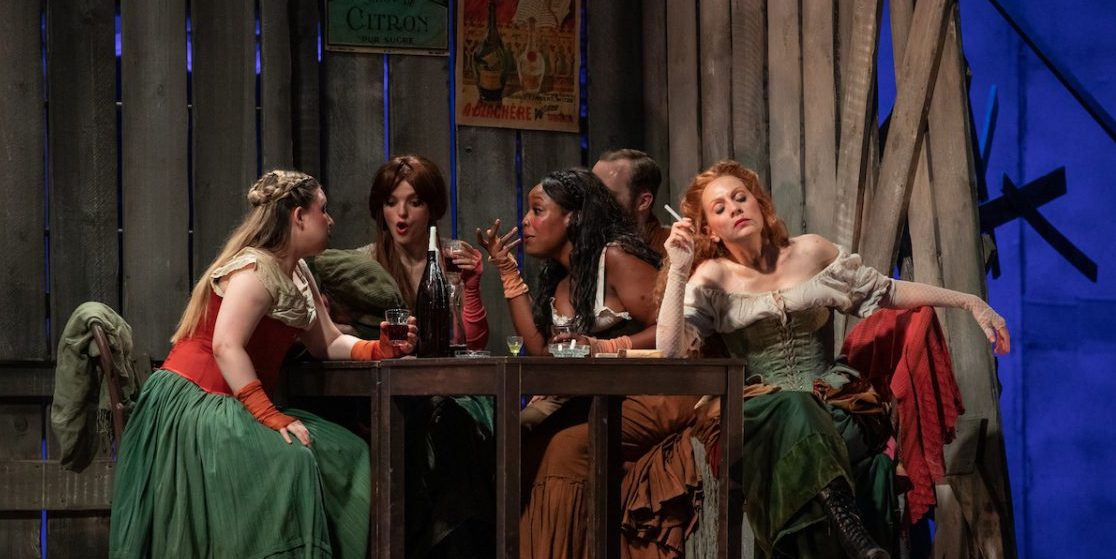One of the most anticipated features of every season at Opera Holland Park is the revived rarity rescued from obscurity. Some fine operas have received a new lease of life through this posthumous patronage, and all have deserved at least an occasional airing. This year, the slot is filled by the unlikely combination of a double-bill by Delius and Puccini, originally scheduled for 2020.
Though some of his most famous works, such as ‘The Walk to the Paradise Garden’ started as music written for the stage, we do not usually think of Delius as an opera composer. In fact he wrote several. ‘Margot la Rouge’ is a one-act piece in ‘verismo’ style, written in 1904 but not performed until 1983. The action takes place in a Parisian dive frequented by prostitutes and other regulars of the ‘demi-monde.’ There is jealousy towards Margot, a red-haired new arrival, who has taken up with the local godfather-figure, L’Artiste. A flurry of newcomers arrives to shelter from a storm and one of a group of soldiers turns out to be a former sweetheart of Margot. He attempts to rescue her only to be thwarted by the alerted L’Artiste, with grisly consequences for some.
The music is effective rather than memorable, but with several moments of lyrical expansiveness including harmonies characteristic of the composer. It is very well delivered by the performers with Anne Sophie Duprels, a regular here at Holland Park, in the title role. She marks the journey well from sullen withdrawal to passionate violence; and Samuel Sakker offers strong, sonorous romantic support both in their main duet and in evoking their shared past. Another OHP stalwart, Paul Carey Jones plays the sinister L’Artiste with authoritative menace.
Great credit should go to designer takis who has provided another ingenious set here which not only adapts into the set for the Puccini second half, but also reassembles into the set for the parallel production of ‘Little Women.’ A plain living room on a revolve allows an economical switch between interior and exterior scenes and clears the way for swift adaptations from bar to church and back again to domestic intimacy.
Puccini’s ‘Le Villi’ was his first operatic outing – a strange confection of opera and ballet on a German supernatural story, that has the flavour of Weber’s ‘Der Freischütz.’ But while it may be a formal oddity among his works, it is remarkable how many of the hallmarks of his mature style are already in place. The long-breathed, sweeping melodies, tight and imaginative orchestration, and sharply-etched characters locked into dramatically compelling dilemmas are all in place. For these reasons alone the piece deserves more frequent outings.
After some scene-setting around the betrothal of the two leads, Anna and Roberto, Roberto departs to claim a legacy and then fails to return. The bride pines away and dies before the returning Roberto himself meets a grim end at the hands of ‘Le Villi’, a group of witches who avenge abandoned women, urged on by Anna’s vengeful father. There are fine arias for the two lovers and Anna’s father and two typical set-pieces, one set in a church which anticipates Puccini’s skills in adapting church music to the stage in ‘Tosca’, and another dance-sequence for the witches in which Anna exacts her revenge.
All the performers distinguish themselves. Francesco Cilluffo and the City of London Sinfonia work up a great head of steam in the orchestral episodes, and especially in the denouement. Anne Sophie Duprels returns in the second half to lead the cast once again and marks the journey from shrinking violet to vengeful ghost with real verve. As her lover, Roberto, Pierre Auty has a couple of demanding arias to negotiate, and apart from some strain in the top register, did this with flair. Stephen Gadd combines the role of narrator and vengeful patriarch with natural authority, and the chorus of villagers intensify the given mood with energy and fluid stage movement.
Given that this is technically an opera-ballet, we should also mention the three dancers who depict the Villi – swathed in many metres of bridal gauze, they manage to stay on the right side of dramatic without tipping over into unintended comedy. Movement director Jami Reid-Quarrell made fully use of the walkway around the orchestra pit and the lighting too managed to add appropriate spectral elements. In the assured hands of director Martin Lloyd-Evans, these two revivals were presented to their full potential: one hopes this will encourage other productions of these works in years to come.

